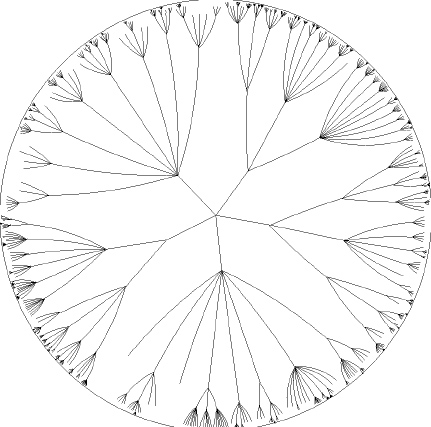Hyperbolic trees: Difference between revisions
No edit summary |
No edit summary |
||
| Line 15: | Line 15: | ||
The [http://www.mcescher.com/Gallery/recogn-bmp/LW436.jpg Circle Limit IV 1960 woodcut in black and ocre], printed from 2 blocks by [http://www.mcescher.com Maurits Cornelis Escher] (1898-1972) was the original inspiration for the hyperbolic browser. | The [http://www.mcescher.com/Gallery/recogn-bmp/LW436.jpg Circle Limit IV 1960 woodcut in black and ocre], printed from 2 blocks by [http://www.mcescher.com Maurits Cornelis Escher] (1898-1972) was the original inspiration for the hyperbolic browser. | ||
The hyperbolic browser shows a tree of hierarchical information with its root initially in the center, but the display can be transformed to bring other nodes into focus. | |||
The following figure shows an original hyperbolic tree with its origin in the center and 1004 nodes: | The following figure shows an original hyperbolic tree with its origin in the center and 1004 nodes: | ||
[[Image:Hyptree original.jpg]] | [[Image:Hyptree original.jpg]] | ||
The origin does not have to be in the center of the fisheye. The focus can be changed by the user either by clicking on any visible point to bring it into focus at the center or by dragging any visble point interactively to any other position: | The origin does not have to be in the center of the fisheye as written above. The focus can be changed by the user either by clicking on any visible point to bring it into focus at the center or by dragging any visble point interactively to any other position: | ||
[[Image:HypTree changinfocus.jpg]] | [[Image:HypTree changinfocus.jpg]] | ||
Revision as of 19:56, 27 April 2006
Authors
Short Description
Suitable Datatypes
This visualization method can be used on hierarchies. With its characteristics the method is especially suitable for the visualization and manipulation of large hierachical data.
Figures
The Circle Limit IV 1960 woodcut in black and ocre, printed from 2 blocks by Maurits Cornelis Escher (1898-1972) was the original inspiration for the hyperbolic browser.
The hyperbolic browser shows a tree of hierarchical information with its root initially in the center, but the display can be transformed to bring other nodes into focus. The following figure shows an original hyperbolic tree with its origin in the center and 1004 nodes:
The origin does not have to be in the center of the fisheye as written above. The focus can be changed by the user either by clicking on any visible point to bring it into focus at the center or by dragging any visble point interactively to any other position:
Examples and use cases
References
[Lamping, et al., 1995] John Lamping, Ramana Rao, Peter Pirolli, A Focus+Context Technique Based on Hyperbolic Geometry for Visualizing Large Hierarchies, Xerox Palo Alto Research Center, Last Retrieved at: April 27, 2006. http://www.acm.org/sigchi/chi95/Electronic/documnts/papers/jl_bdy.htm
[edit] 3 References

